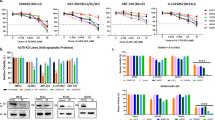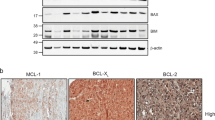Abstract
There are few effective treatments for metastatic melanoma. Checkpoint kinase 1 (Chk1) inhibitors are being trialled for their efficacy in enhancing conventional chemotherapeutic agents, but their effectiveness as single agents is not known. We have examined the effectiveness of two novel Chk1 selective inhibitors, AR323 and AR678, in a panel of melanoma cell lines and normal cell types. We demonstrate that these drugs display single-agent activity, with IC50s in the low nanomolar range. The drugs produce cytotoxic effects in cell lines that are most sensitive to these drugs, whereas normal cells are only sensitive to these drugs at the higher concentrations where they have cytostatic activity. The cytotoxic effect is the consequence of inhibition of S-phase Chk1, which drives cells prematurely from late S phase into an aberrant mitosis and results in either failure of cytokinesis or cell death through an apoptotic mechanism. The sensitivity to the Chk1 inhibitors was correlated with the level of endogenous DNA damage indicating replicative stress. Chk1 inhibitors are viable single-agent therapies that target melanoma cells with high levels of endogenous DNA damage. This sensitivity suggests that Chk1 is a critical component of an adaptation to replicative stress in these cells. It also suggests that markers of DNA damage may be useful in identifying the melanomas and potentially other tumour types that are more likely to be sensitive to Chk1 inhibitors as single agents.
This is a preview of subscription content, access via your institution
Access options
Subscribe to this journal
Receive 50 print issues and online access
$259.00 per year
only $5.18 per issue
Buy this article
- Purchase on Springer Link
- Instant access to full article PDF
Prices may be subject to local taxes which are calculated during checkout







Similar content being viewed by others
References
McDonald 3rd ER, El-Deiry WS . Checkpoint genes in cancer. Ann Med 2001; 33: 113–122.
Stewart ZA, Westfall MD, Pietenpol JA . Cell-cycle dysregulation and anticancer therapy. Trends Pharmacol Sci 2003; 24: 139–145.
Lazzaro F, Giannattasio M, Puddu F, Granata M, Pellicioli A, Plevani P et al. Checkpoint mechanisms at the intersection between DNA damage and repair. DNA Repair (Amst) 2009; 8: 1055–1067.
Kaelin WG Jr . The concept of synthetic lethality in the context of anticancer therapy. Nat Rev Cancer 2005; 5: 689–698.
Dai Y, Grant S . New insights into checkpoint kinase 1 in the DNA damage response signaling network. Clin Cancer Res 2010; 16: 376–383.
Liu Q, Guntuku S, Cui XS, Matsuoka S, Cortez D, Tamai K et al. Chk1 is an essential kinase that is regulated by Atr and required for the G(2)/M DNA damage checkpoint. Genes Dev 2000; 14: 1448–1459.
Sorensen CS, Hansen LT, Dziegielewski J, Syljuasen RG, Lundin C, Bartek J et al. The cell-cycle checkpoint kinase Chk1 is required for mammalian homologous recombination repair. Nat Cell Biol 2005; 7: 195–201.
Wang W . Emergence of a DNA-damage response network consisting of Fanconi anaemia and BRCA proteins. Nat Rev Genet 2007; 8: 735–748.
Brown EJ, Baltimore D . ATR disruption leads to chromosomal fragmentation and early embryonic lethality. Genes Dev 2000; 14: 397–402.
Takai H, Tominaga K, Motoyama N, Minamishima YA, Nagahama H, Tsukiyama T et al. Aberrant cell cycle checkpoint function and early embryonic death in Chk1(-/-) mice. Genes Dev 2000; 14: 1439–1447.
Ge XQ, Blow JJ . Chk1 inhibits replication factory activation but allows dormant origin firing in existing factories. J Cell Biol 2010; 191: 1285–1297.
Petermann E, Woodcock M, Helleday T . Chk1 promotes replication fork progression by controlling replication initiation. Proc Natl Acad Sci USA 2010; 107: 16090–16095.
Kramer A, Mailand N, Lukas C, Syljuasen RG, Wilkinson CJ, Nigg EA et al. Centrosome-associated Chk1 prevents premature activation of cyclin-B-Cdk1 kinase. Nat Cell Biol 2004; 6: 884–891.
Loffler H, Rebacz B, Ho AD, Lukas J, Bartek J, Kramer A . Chk1-dependent regulation of Cdc25B functions to coordinate mitotic events. Cell Cycle 2006; 5: 2543–2547.
Ma CX, Janetka JW, Piwnica-Worms H . Death by releasing the breaks: CHK1 inhibitors as cancer therapeutics. Trends Mol Med 2011; 17: 88–96.
Kuntz K, O’Connell MJ . The G(2) DNA damage checkpoint: could this ancient regulator be the Achilles heel of cancer? Cancer Biol Ther 2009; 8: 1433–1439.
Morgan MA, Parsels LA, Zhao L, Parsels JD, Davis MA, Hassan MC et al. Mechanism of radiosensitization by the Chk1/2 inhibitor AZD7762 involves abrogation of the G2 checkpoint and inhibition of homologous recombinational DNA repair. Cancer Res 2010; 70: 4972–4981.
Chen MS, Ryan CE, Piwnica-Worms H . Chk1 kinase negatively regulates mitotic function of Cdc25A phosphatase through 14-3-3 binding. Mol Cell Biol 2003; 23: 7488–7497.
Syljuasen RG, Sorensen CS, Hansen LT, Fugger K, Lundin C, Johansson F et al. Inhibition of human Chk1 causes increased initiation of DNA replication, phosphorylation of ATR targets, and DNA breakage. Mol Cell Biol 2005; 25: 3553–3562.
Nazarian R, Shi H, Wang Q, Kong X, Koya RC, Lee H et al. Melanomas acquire resistance to B-RAF(V600E) inhibition by RTK or N-RAS upregulation. Nature 2010; 468: 973–977.
Lainchbury M, Collins I . Checkpoint kinase inhibitors: a patent review (2009–2010). Expert Opin Ther Pat 2011; 21: 1191–1210.
Davies KD, Humphries MJ, Sullivan FX, von Carlowitz I, Le Huerou Y, Mohr PJ et al. Single-agent inhibition of Chk1 is antiproliferative in human cancer cell lines in vitro and inhibits tumor xenograft growth in vivo. Oncol Res 2011; 19: 349–363.
O’Driscoll M, Ruiz-Perez VL, Woods CG, Jeggo PA, Goodship JA . A splicing mutation affecting expression of ataxia-telangiectasia and Rad3-related protein (ATR) results in Seckel syndrome. Nat Genet 2003; 33: 497–501.
Niida H, Tsuge S, Katsuno Y, Konishi A, Takeda N, Nakanishi M . Depletion of Chk1 leads to premature activation of Cdc2-cyclin B and mitotic catastrophe. J Biol Chem 2005; 280: 39246–39252.
Tang J, Erikson RL, Liu X . Checkpoint kinase 1 (Chk1) is required for mitotic progression through negative regulation of polo-like kinase 1 (Plk1). Proc Natl Acad Sci USA 2006; 103: 11964–11969.
Burgess A, Ruefli A, Beamish H, Warrener R, Saunders N, Johnstone R et al. Histone deacetylase inhibitors specifically kill nonproliferating tumour cells. Oncogene 2004; 23: 6693–6701.
McNeely S, Conti C, Sheikh T, Patel H, Zabludoff S, Pommier Y et al. Chk1 inhibition after replicative stress activates a double strand break response mediated by ATM and DNA-dependent protein kinase. Cell Cycle 2010; 9: 995–1004.
Gabrielli BG, De Souza CP, Tonks ID, Clark JM, Hayward NK, Ellem KA . Cytoplasmic accumulation of cdc25B phosphatase in mitosis triggers centrosomal microtubule nucleation in HeLa cells. J Cell Sci 1996; 109: 1081–1093.
Peddibhotla S, Lam MH, Gonzalez-Rimbau M, Rosen JM . The DNA-damage effector checkpoint kinase 1 is essential for chromosome segregation and cytokinesis. Proc Natl Acad Sci USA 2009; 106: 5159–5164.
Nitta M, Kobayashi O, Honda S, Hirota T, Kuninaka S, Marumoto T et al. Spindle checkpoint function is required for mitotic catastrophe induced by DNA-damaging agents. Oncogene 2004; 23: 6548–6558.
Gabrielli B, Chau YQ, Giles N, Harding A, Stevens F, Beamish H . Caffeine promotes apoptosis in mitotic spindle checkpoint-arrested cells. J Biol Chem 2007; 282: 6954–6964.
Castedo M, Perfettini JL, Roumier T, Andreau K, Medema R, Kroemer G . Cell death by mitotic catastrophe: a molecular definition. Oncogene 2004; 23: 2825–2837.
Vogel C, Hager C, Bastians H . Mechanisms of mitotic cell death induced by chemotherapy-mediated G2 checkpoint abrogation. Cancer Res 2007; 67: 339–345.
Myers K, Gagou ME, Zuazua-Villar P, Rodriguez R, Meuth M . ATR and Chk1 suppress a caspase-3-dependent apoptotic response following DNA replication stress. PLoS Genet 2009; 5: e1000324.
Sidi S, Sanda T, Kennedy RD, Hagen AT, Jette CA, Hoffmans R et al. Chk1 suppresses a caspase-2 apoptotic response to DNA damage that bypasses p53, Bcl-2, and caspase-3. Cell 2008; 133: 864–877.
Bartkova J, Rezaei N, Liontos M, Karakaidos P, Kletsas D, Issaeva N et al. Oncogene-induced senescence is part of the tumorigenesis barrier imposed by DNA damage checkpoints. Nature 2006; 444: 633–637.
Taylor WR, Stark GR . Regulation of the G2/M transition by p53. Oncogene 2001; 20: 1803–1815.
Wasco MJ, Pu RT, Yu L, Su L, Ma L . Expression of gamma-H2AX in melanocytic lesions. Hum Pathol 2008; 39: 1614–1620.
Wang XQ, Gabrielli BG, Milligan A, Dickinson JL, Antalis TM, Ellem KA . Accumulation of p16CDKN2A in response to ultraviolet irradiation correlates with late S-G(2)-phase cell cycle delay. Cancer Res 1996; 56: 2510–2514.
Stevens FE, Beamish H, Warrener R, Gabrielli B . Histone deacetylase inhibitors induce mitotic slippage. Oncogene 2008; 27: 1345–1354.
Ranall MV, Gabrielli BG, Gonda TJ . Adaptation and validation of DNA synthesis detection by fluorescent dye derivatization for high-throughput screening. Biotechniques 2010; 48: 379–386.
Acknowledgements
We wish to acknowledge Drs Kurt Davies and Cheryl Napier (Array Biopharma), and KeeMing Chia for their technical assistance, A/Professor Grant McArthur and Dr Petranel Ferrao for their helpful comments, Prof. Penny Jeggo (University of Sussex) for her gift of the FO2 cells, and the Australasian Biospecimen Network (Oncology) for the melanoma cell lines. This work was supported by funding from Cancer Council Queensland, the National Health and Medical Research Council (NHMRC Australia) and the Australia Research Council. Brian Gabrielli is an NHMRC senior research fellow.
Author information
Authors and Affiliations
Corresponding author
Ethics declarations
Competing interests
The authors declare no conflict of interest.
Additional information
Supplementary Information accompanies the paper on the Oncogene website
Supplementary information
Rights and permissions
About this article
Cite this article
Brooks, K., Oakes, V., Edwards, B. et al. A potent Chk1 inhibitor is selectively cytotoxic in melanomas with high levels of replicative stress. Oncogene 32, 788–796 (2013). https://doi.org/10.1038/onc.2012.72
Received:
Revised:
Accepted:
Published:
Issue Date:
DOI: https://doi.org/10.1038/onc.2012.72
Keywords
This article is cited by
-
Targeting CDC7 potentiates ATR-CHK1 signaling inhibition through induction of DNA replication stress in liver cancer
Genome Medicine (2021)
-
Sensitivity of cells to ATR and CHK1 inhibitors requires hyperactivation of CDK2 rather than endogenous replication stress or ATM dysfunction
Scientific Reports (2021)
-
Roles of Claspin in regulation of DNA replication, replication stress responses and oncogenesis in human cells
Genome Instability & Disease (2021)
-
Analysis of the ATR-Chk1 and ATM-Chk2 pathways in male breast cancer revealed the prognostic significance of ATR expression
Scientific Reports (2017)
-
Tumour growth environment modulates Chk1 signalling pathways and Chk1 inhibitor sensitivity
Scientific Reports (2016)



